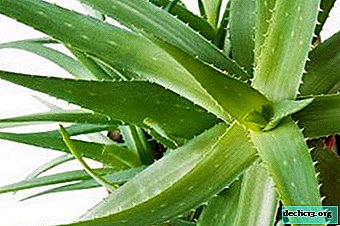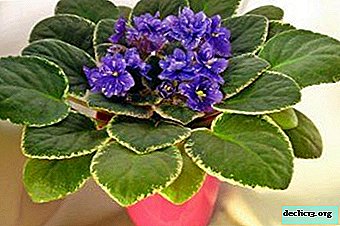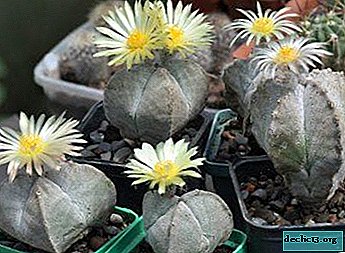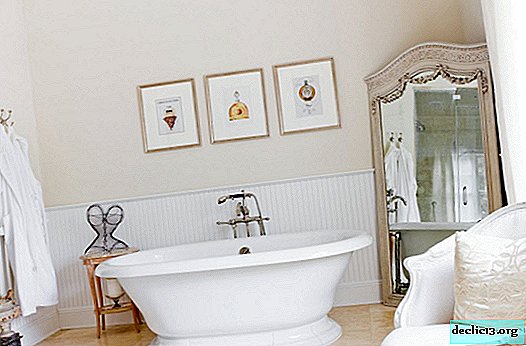We care with love: how to water aloe properly?

Juicy green leaves, lack of mold and dust on the plant, sufficiently moist, but not wet soil in the pot - all these are signs of a healthy aloe, which is properly looked after. Aloe is not a demanding plant at all, but at home it can suffer from a lack of care. Do not neglect the basic rules for caring for aloe.
Particular care must be taken to water it. Experts recommend using clean, settled water for irrigation of aloe. The temperature of the liquid should vary depending on the season, that is, for winter and autumn, the ideal water temperature is 6-8 degrees above room temperature. In spring and summer, water can be heated from 20 to 35 degrees. Mistakes in this case can lead to aloe diseases.
In which organs does the flower store moisture?
Irrigation frequency and water quality are important for aloe. Water serves as a building material for its tissues. Absorbed by the roots from the soil, moisture rises along the stem to the leaves and carries the nutrients necessary for the normal development of the plant.Aloe has a thick stem and fleshy leaves. Aloe refers to succulents that have the ability to store water in organs. Using these reserves, the plant is able to survive in the complete absence of external sources of moisture.
How often should I water?
How to water an aloe vera flower at home? This should be done moderately. The frequency of the procedures is determined by the humidity and ambient temperature, the amount of light, the season and the age of the plant.
 The older the aloe, the less watering required. Rooting young specimens are watered more often.
The older the aloe, the less watering required. Rooting young specimens are watered more often.
In the summer, the substrate is moistened once or twice a week, closer to the evening. The signal for irrigation is the drying of the upper soil layer a few centimeters from the surface. In high humidity and rainy weather, frequent treatments can harm aloe.
Ordinary water, taken directly from the water supply, is not suitable for irrigation - it contains heavy and alkaline impurities that adversely affect plants. Water should be soft. It is recommended to defend it for more than a day.
This will allow lime and chlorine to evaporate. Another way to mitigate is boiling. To normalize acidity, it is recommended to add acetic or citric acid to the water in a ratio of three to five grams per liter of water.
It is important to pay attention to the temperature of the water. In summer, the temperature should be from +30 to + 35 ° C, in spring from +20 to + 22 ° C, in the autumn-winter season - above room temperature by 6 - 8 ° C.
How to moisturize a plant that is at home?
There are two ways to water aloe:
- from below;
- on top - using a watering can with a thin nose.
The method is more suitable for those types of aloe, whose suction roots are located in the lower part of the root system, at the bottom of the pot.
This method does not lead to erosion of the soil. Nutrients are washed slowly. If the root system is powerful and thick, this method is not recommended. High drainage prevents moisture from entering the upper layers of the substrate, which can cause root diseases.
If there is a thick drainage layer, you need to immerse the pot in a deep container with water for several minutes. Then allow excess moisture to drain and put the pot back on the pan.
 Watering from above is necessary for large species. Such specimens need watering that runs smoothly from the root neck to the roots. It is important to saturate the soil with moisture at a time so that it reaches the bottom layer. If not enough water is poured, the root system may dry. The method is not suitable for watering those aloes that have small root hairs.
Watering from above is necessary for large species. Such specimens need watering that runs smoothly from the root neck to the roots. It is important to saturate the soil with moisture at a time so that it reaches the bottom layer. If not enough water is poured, the root system may dry. The method is not suitable for watering those aloes that have small root hairs.
With the right amount of water, half an hour after watering, moisture should accumulate from the watering can in the pan. It should be poured, otherwise the roots may rot.
Watering needs to be done very carefully, along the edge of the pot, preventing the leaves and stem from getting wet. Excess moisture on the leaves causes them to rot. Aloe can not be sprayed and placed in the shower. If dust has accumulated on the leaves, wipe them with a damp cloth.
In the spring and summer, watering is periodically combined with aloe top dressing. Once a month, a weak solution of mineral fertilizer intended for succulents is introduced.
How many times moisturize in the winter?
Winter is the time when aloe is at rest. Watering should be done no more than once a month, preferably in the morning. Keep the soil in the pot dry. In winter, aloe is not fed.
What will happen if you do not follow the rules?
- Aloe is very difficult to tolerate excess moisture. In this case, its leaves turn yellow and soften. It is necessary to remove the plant from the pot, inspect the root system and remove the damaged areas. To dry. Plant in new soil and provide good lighting.
- If aloe drops unexpectedly, the cause is cold water.
- With excessive moisture, stagnation of water in the pot may occur.In combination with low air temperature, stagnation of water provokes the development of root rot. You can save the plant only at an early stage of this disease.
- If aloe is not watered for a long time, its leaves lose turgor, become lethargic and thin. Excessive moisture in the substrate will help correct the situation.
Watering aloe is not particularly difficult. The flower does not need frequent moistening of the soil and without loss experiences a short drought. A great role for aloe is played by the quality of water. Proper irrigation helps avoid root system problems. and maintain plant health.
Useful video
We offer you to watch a video on how to properly water aloe at home:
















